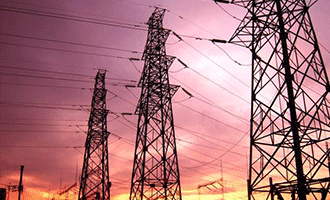
In 2006, China's first ultra-high voltage power grid project, the State Grid Corporation of China's Jindongnan Nanyang Jingmen AC ultra-high voltage test demonstration project, was grandly laid in Changzhi, Shanxi, marking the official entry of the construction phase of the AC ultra-high voltage power grid project with a voltage level of one million volts; On December 21, 2007, the Sichuan Shanghai ± 800 kV high-voltage direct current transmission demonstration project started construction in Yibin, Sichuan. This is the world's highest voltage level, longest transmission distance, and largest capacity direct current transmission project planned and constructed.
present situation
China's installed power capacity, 1949: 1.85 million kilowatts; Before the reform and opening up in 1978: 57.12 million kilowatts; In 1987, it exceeded 100 million kilowatts; In 1995, 200 million kilowatts were achieved; 2000: 300 million kilowatts; In 2002: 350 million kilowatts; In 2003: 390 million kilowatts; In 2004: 440 million kilowatts; In 2005: 517 million kilowatts; In 2006: 622 million kilowatts; In 2007: 713 million kilowatts; The newly added installed electricity capacity from 2002 to 2007 is equivalent to the total of the past 53 years.
In recent years, with the accelerating pace of China's power development, the Chinese power grid has also developed rapidly. The operating voltage level of the power grid system has been continuously improved, and the network scale has also been continuously expanded. The country has formed six large cross provincial regional power grids, namely Northeast Power Grid, North China Power Grid, Central China Power Grid, East China Power Grid, Northwest Power Grid, and Southern Power Grid, and has basically formed a complete long-distance transmission grid structure.
In 2006, China's power grid construction maintained a relatively high scale, with a total investment of 210.575 billion yuan in national power grid construction, a year-on-year increase of nearly 38%. In 2006, with a batch of West East Power Transmission projects put into operation, the three major channels of China's West East Power Transmission have accumulated a transmission capacity of 34 million kilowatts.
In 2007, the national investment in power grid construction was 245.14 billion yuan, an increase of 16.41% year-on-year. Add 41500 kilometers of circuit length for transmission lines of 220 kV and above. As of the end of 2007, the total length of 220 kV and above transmission lines in China reached 327100 kilometers, a year-on-year increase of 14.20%.
By the end of 2008, the installed capacity of electricity reached 792.53 billion kilowatts, and the power generation reached 3433.4 billion kilowatt hours.
The substation capacity has reached 2.2 billion kVA, which is 4.2 times that of 2002, with an average annual growth rate of 17.26%.
“
During the 11th Five Year Plan period, it was an important five-year period for China's power grid construction to carry forward the past and open up the future, with a large number of major transmission projects starting construction. Among them, a number of high-level, long-distance, and high-capacity transmission projects such as Hainan Interconnection, Huliao DC, Xinjiang and Northwest Interconnection, and ultra-high voltage AC and DC have been completed and put into operation, ushering in the era of China's large power grid and promoting the enhancement of cross regional power exchange capacity. At the end of 2009, the national cross regional power exchange capacity exceeded 25 million kilowatts, and the annual cross regional trading electricity reached 121.3 billion kilowatt hours, an increase of 51.1% compared to 2005. The scale of China's power grid has surpassed that of the United States, ranking first in the world.
By the end of 2010, the total length of 220 kV and above transmission lines in China had reached 430000 kilometers, with a substation capacity of 1.96 billion kVA, which was 1.7 times and 2.4 times that of the end of the 15th Five Year Plan, respectively. The scale of the power grid had jumped to the top in the world. In the first three quarters of 2011, the national power grid project completed an investment of 220.1 billion yuan, and the power grid construction added 128.17 million kilovolt amperes and above of substation capacity, with a line length of 22507 kilometers. From January to September 2011, the national cross regional power transmission reached 128.6 billion kilowatt hours, a year-on-year increase of 22.6%; The cross provincial output of electricity in China reached 479.1 billion kilowatt hours, a year-on-year increase of 8.3%.
The pace of China's smart grid construction is accelerating, and the ultra-high voltage power grid project is progressing smoothly. The 1000 kV Jindongnan Nanyang Jingmen ultra-high voltage AC test demonstration project has successfully passed the national acceptance, marking that ultra-high voltage is no longer in the "test" and "demonstration" stage. In October 2011, the Anhui East Transmission Huainan to Shanghai UHVAC Transmission Demonstration Project was approved by the National Development and Reform Commission, becoming the second UHVAC transmission project approved for construction in China after the Jindongnan Jingmen Transmission Project. In 2011, China's strong smart grid entered the comprehensive construction stage, vigorously promoting demonstration projects, electric vehicle charging and swapping facilities, new energy acceptance, and intelligent residential electricity use.
In 2012, State Grid Corporation of China's bidding volume for smart meters reached 75.8869 million units, completing 138% of the planned quantity and a year-on-year increase of 12.17%.
The construction of the power grid has become the main direction of China's power construction, and the prospect of power grid construction is promising. During the 12th Five Year Plan period, the investment scale of China's power grid continued to expand, and by 2020, a unified and strong smart grid will be fully built, achieving the goal of building a world-class power grid.



